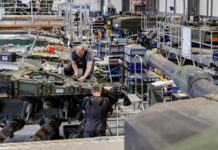C4 architecture employed at the Brigade level and above, requires multiple links between distributed and remote command posts, integrated into the brigade’s C4 network. Past systems required vertical integration of every branch, by parallel communications links resulting in complex, costly and unreliable networking solutions. Current systems are integrated over a common mesh network infrastructure, sharing a common grid, and Geographic Information Database (GIS).
It is implemented by the use of standard IP based communications over broadband wireless datalinks, including ATM or WiMAX wireless networks, providing rates of 54 Mbps over an area of 50 km. To sustain the bandwidth and connectivity to higher echelons, broadband wireless links and satellite are required. Connectivity with the lower echelon (battalion, recce etc) is provided with high capacity data radios, sustaining around 0.5 Mbps data rates. Other services are networking the elements of the command post. These utilize various types of wireless LANs, particularly WiFi (802.11)systems. This technology enables CPs to be distributed over a larger area, without characteristic signatures of tents or shelter complexes that could be easily detected from the air or from space. Protection of wireless networks, particularly COTS based, require special security measures, securing the data and the communications channel itself. In addition, protection measures for the network itself are required, particularly against penetration, exploitation, service denial and other types of attacks, carried out by computer worms, Trojan Horses and malicious code attacks. Future networks, under development today, will feature advanced and flexible Mobile Area Networks (MANET) offering self-forming, self-healing ad-hoc networks. Among the programs currently evaluated in the USA are MOSAIC, MIMO and others.
Internet Protocol (IP) based connectivity enables seamless integration of information from different sources, where needed, resulting in a more economical use of available assets. Contemporary command and control networks implement common reporting protocols, collecting and preparing tactical situation reports automatically dispatched by tactical formations from the lowest echelons. Such automatic reports include locations and status of available supplies, ammunition levels in each vehicle, system’s health status, etc. Reports are provided with time stamps and position data, to automatically generated situational pictures, and synchronized by time and space at the brigade level. The processing of this data can indicate important trends, predictions and timelines or spatial data presentations which are not readily available with current reporting systems. Logistical status reports can be formatted and generated manually, or automatically, using RFID inventory tracking technology.
This feature continues to cover the following topics:
- Tactical C4 Networking Challenges
- Building Blocks of C4 Systems
- Vehicular C4 Applications
- C4 for the Battalion Level
- Situation Assessment Tools For Dismounted Leaders
- Brigade’s Tactical Operations Center
- Common Operation Picture (COP)
- The Modern Command post
- C4 Networking Architecture
- Mission planning Tools



















